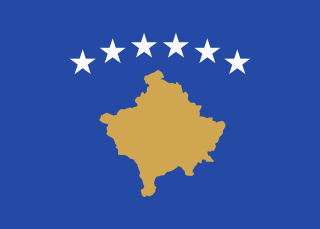
Kosovo, officially the Republic of Kosovo, is a landlocked country in Southeast Europe with partial diplomatic recognition. It is bordered by Albania to the southwest, Montenegro to the west, Serbia to the north and east and North Macedonia to the southeast. It covers an area of 10,887 km2 (4,203 sq mi) and it has a population of approximately 1.6 million. Kosovo has a varied terrain, with high plains along with rolling hills and mountains, some of which reach an altitude of over 2,500 m (8,200 ft). Its climate is mainly continental with some Mediterranean and alpine influences. Kosovo's capital and the most populous city is Pristina; other major cities and urban areas include Prizren, Ferizaj, Gjilan and Peja.
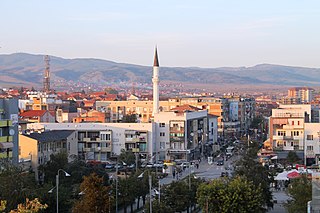
Gjilan or Gnjilane is the fourth most populous city in Kosovo and it serves as both a municipality and the administrative center of the Gjilan District. According to the 2024 census, the municipality of Gjilan has a population of 82,901 with the majority residing in the city.

Prizren is the second most populous city and municipality of Kosovo and seat of the eponymous municipality and district. It is located on the banks of the Prizren River between the foothills of the Sharr Mountains in southern Kosovo. Prizren experiences a continental climate with some mediterranean influences.
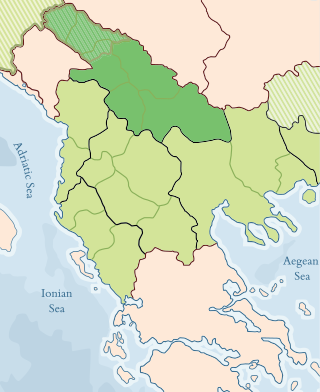
The Vilayet of Kosovo was a first-level administrative division (vilayet) of the Ottoman Empire in the Balkan Peninsula which included the modern-day territory of Kosovo and the north-western part of the Republic of North Macedonia. The areas today comprising Sandžak (Raška) region of Serbia and Montenegro, although de jure under Ottoman control, were de facto under Austro-Hungarian occupation from 1878 until 1909, as provided under Article 25 of the Treaty of Berlin. Üsküb (Skopje) functioned as the capital of the province and the midway point between Istanbul and its European provinces. Üsküb's population of 32,000 made it the largest city in the province, followed by Prizren, also numbering at 30,000.
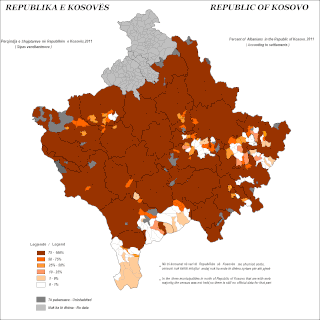
The Albanians of Kosovo, also commonly called Kosovo Albanians, Kosovan Albanians or Kosovars, constitute the largest ethnic group in Kosovo.

The University of Pristina is a public university located in Pristina, Kosovo. It is the institution that emerged after the disestablishment of the University of Pristina (1969–1999) as a result of the Kosovo War. The inauguration of the university was a historical occurrence not only for the people of Kosovo, but for the whole Albanian nation. On 15 February, the solemn Parliament session took place, which is also proclaimed as The University of Pristina's Day. In the composition of the newly established University of Pristina were faculties with their headquarters in Pristina: the Faculty of Philosophy, Faculty of Law and Economics, Faculty of Engineering and Faculty of Medicine. Now the University of Pristina has 17 faculties, of which 14 are academic faculties and 3 are faculties of applied sciences. Contained within the emblem is a translation of the name into Latin, Universitas Studiorum Prishtiniensis.

Skopska Crna Gora or Karadak Mountains, often called simply Crna Gora, is a mountain range and ethnographic region in North Macedonia, Kosovo and Serbia. The highest peak is Ramno 1,651 m (5,417 ft) in Macedonia. The largest town on the mountain is Kučevište in North Macedonia.

Transport in Kosovo consists of transport by land and air. After the Kosovo's independence, improvements to the road infrastructure, urban transport, rail transport and air travel have all led to a vast improvement in transportation. These upgrades have played a key role in supporting Kosovo's economy.
Lorenc Antoni was an Albanian composer, conductor, and ethnomusicologist.
Tourism in Kosovo is characterized by archaeological heritage from Illyrian, Dardanian, Roman, Byzantine, Serbian and Ottoman times, traditional Albanian and Serbian cuisine, architecture, religious heritage, traditions, and natural landscapes. Kosovo is situated in south-eastern Europe. With its central position in the Balkans, it serves as a link in the connection between central and south Europe, the Adriatic Sea, and Black Sea.
Classical music in Kosovo refers to the art music cultivated in Kosovo. The roots of classical music in Kosovo are found in the 1940s and include the time period from the times when Kosovo was part of Yugoslavia to this day. It can be said that there is a tradition of classical music in Kosovo, however, compared to other Balkan countries and especially European countries this tradition is younger. Classical music in Kosovo reaches back about 70 years. Even though in a short period of time, this music has evolved, passing through generations of composers and artists. In his book Albanian: Zhvillimi i stileve në veprat e kompozitorëve shqiptarë të Kosovës, Engjëll Berisha comments:
The diversity of styles in Albanian music [of Kosovo], its national patterns with sound idea-aesthetic foundations are a characteristic of the European musical reality, so many many works are of interest abroad, too, because during this relatively short period Albanian classical music in Kosovo has compensated for the delay in its development.
The literature of Kosovo is composed of literary texts written in Albanian, Serbian, Bosnian, and Turkish, specifically by authors of Kosovo. Kosovo produced several prominent writers in the Ottoman era. However, Ottoman authorities banned the written use of the Albanian language until 1912. This policy continued during Serb rule until the outbreak of World War II.
Nijazi Ramadani is a Kosovar Albanian poet, novelist and literary critic.

The National Theatre of Kosovo was founded in 1946 in the city of Prizren, Kosovo. It is the highest ranked theatre institution in the country, with the largest number of productions. The National Theatre is the only public theatre in Kosovo and therefore it is financed by Ministry of Culture, Youth and Sport. This theatre has produced more than 400 premieres which have been watched by more than 3 million spectators.
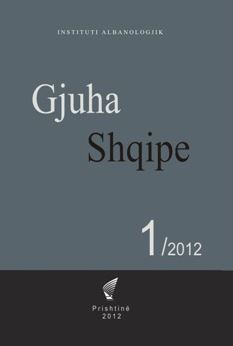
Gjuha Shqipe is a scientific magazine published by the Albanological Institute. It focuses on topics related to the Albanian language, its purification, spread, and development, and possible changes on its standard form.
Musë Prelvukaj is a Kosovar artist born in Martinovići, near Gusinje and Plav in what is now Montenegro, on December 25, 1950.

The Sopa or Sopi tribe is a historical Albanian tribe (fis) originating from the Sharr Mountains of today's Kosovo, Albania and North Macedonia. Members of the tribe can be found in many Albanian-inhabited regions of Kosovo and North Macedonia, specifically in and around Prizren.

The insurgency in Karadak–Gollak, also known as the War in Eastern Kosovo, was a series of Albanian riots in the Karadak and Gollak regions with spillover into the Anamorava regions. Initially directed against Bulgarian, German, and Italian occupation following the Invasion of Yugoslavia in 1941, it later targeted the Yugoslav Partisans who were attempting to gain control of the area.
Mulla Jusuf Baftjari, also known as Hoxhë Lipovica, was a prominent Albanian Imam, later Mullah, Kachak and Ballist commander during the Insurgency in Karadak in World War II, a region predominantly inhabited by Muslim Albanians. He participated in the popular resistance against the Bulgarian fascists, Yugoslav Partisans and Chetniks in the Karadak region. Jusuf Baftjari, was renowned for his wisdom and religious leadership and emerged as a prominent figure among the Albanians of Karadak. Jusuf Baftjari led significant battles in Karadak, Anamorava and Gollak including the one in Rainca of Presheva. On Eid al-Adha in 1944, Jusuf Baftjari organized and led the fighting during the First Battle of Preševo. Even after the end of World War II, Jusuf Baftjari continued the armed resistance against Yugoslavia, being one of the last Ballist leaders in Kosovo to do so.












